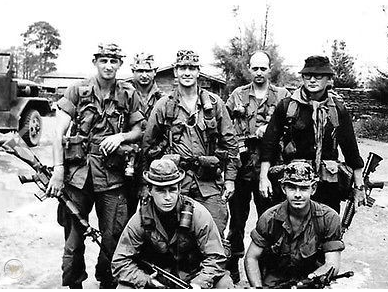Salem House Operations
Concurrent with the Prairie Fire operations were the SOG’s missions in northeastern Cambodia. These operations, originally named ‘Daniel Boone,’ were later redesignated ‘Salem House.’ These missions provided intelligence on North Vietnamese and Viet Cong bases located in Cambodia. Another objective of the Salem House operations was to determine the level of Cambodian Government support for the NVA and Viet Cong.
The Salem House operations had several restrictions that affected their activities in Cambodia. Many of the restrictions were modified or withdrawn and new restrictions imposed; the pattern of change in the restrictions presents an interesting picture of the war’s development in Cambodia. In May 1967, the Salem House missions were subject to the following restrictions:
Only reconnaissance teams were to be committed into Cambodia and the teams could not exceed an overall strength of 12 men, to include not more than three U.S. advisers.
Teams were not to engage in combat except to avoid capture.
They did have permission to have contact with civilians.
No more than three reconnaissance teams could be committed on operations in Cambodia at any one time.
The teams could conduct no more than ten missions in any 30-day period.

By October 1967, SOG’s teams had permission to infiltrate the entire Cambodian border area to a depth of 20 kilometers. However, their helicopters were only permitted ten kilometers inside Cambodia. In December, the DOD, with the Department of State’s concurrence, approved the use of Forward Air Controllers (FACs) to support SOG operations. The FACs had authorization to make two flights in support of each Salem House mission.
In October 1968, SOG teams received permission to emplace self-destructing land mines in Cambodia. The following December, the depth of penetration into northern Cambodia was extended to 30 kilometers; however, the 20-kilometer limit remained in effect for central and southern Cambodia. The final adjustment in Salem House operations made in 1970 during the incursion into Cambodia permitted reconnaissance teams to operate 200 meters west of the Mekong River (an average distance of 185 kilometers west of the South Vietnamese border). However, the SOG reconnaissance teams never ventured that far west, due to the lift and range limitations of their UH-1F helicopters. Thus from the initiation of SOG’s Cambodian operations in 1967 until 1970, there was a progressive expansion of the zones of operation and OPS-35 patrols within Cambodia. The enlargement of the areas of operation and the increasing number of Salem House missions, gives an indication of how seriously the Johnson and Nixon Administrations viewed the NVA’s use of Cambodian base areas. It was also indicative of the U.S. military’s growing awareness of the role of the Central Office for South Vietnam (COSVN) and its deleterious effect on the war in South Vietnam.
From 1967 through April 1972, OPS-35 conducted 1,398 reconnaissance missions, 38 platoon-sized patrols, and 12 multi-platoon operations in Cambodia. During the same period, it captured 24 prisoners of war.

